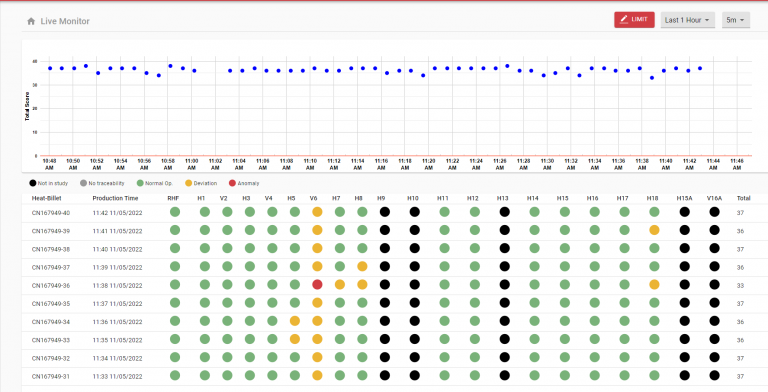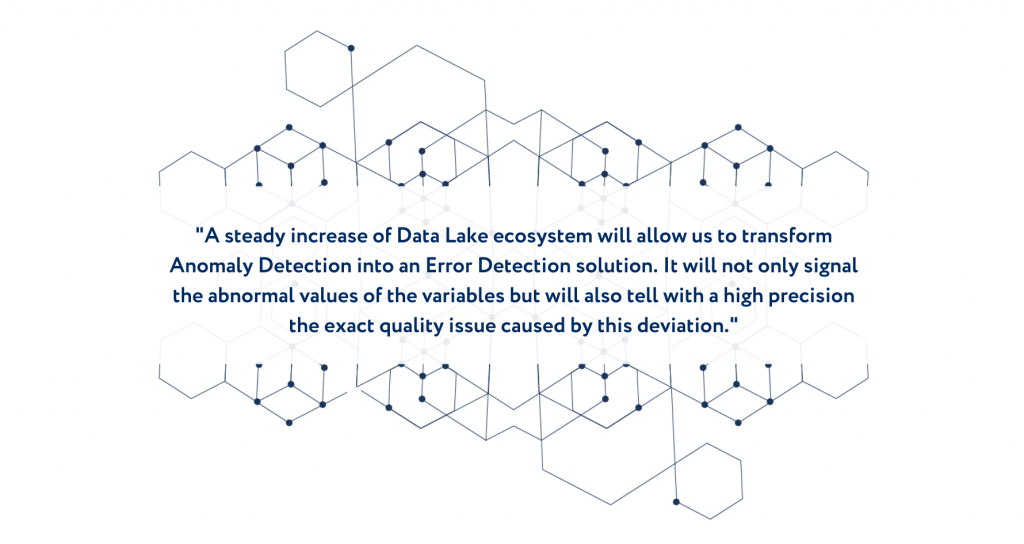In heavy industry the correlation between the Quality Control, Cost Reduction and Labour Safety is seen more than in any other sectors, as well as the importance of using Data Science in its manufacturing processes. Because even with an IoT system in place it is not a simple task to analyse data, detect anomaly in real time and take immediate actions to avoid cobbles and defects in the produced construction materials. Without using proper AI-based tools that would reinforce Anomaly Detection in manufacturing the consequences of the overseen anomalies may be costly, disruptive and irrevocable.
To be able to identify abnormal process behaviour and potential incidents, CELSA Nordic asked Aquiles Solutions (Technological Partner of the CELSA GROUP) to deploy a solution that would detect anomalies, pre-analyze data and present it in an interactive dashboard. Such application was designed with the help of Machine Learning (ML) models trained on the existing Data Lake.

IoT & Machine Learning models
Process Partner success story is talking about the deployment of a monitoring application based on Machine Learning Models capable of identifying abnormal process behaviour and potential incidents. The solution is a combination of the upgraded applications, ZeroCobble and R-Factor process control, that were already implemented in the pilot plants.
The purpose of the Process Partner is to generate Statistical Process Control charts (SPC) and Machine Learning (ML) model prediction with the collected data, focusing on anomaly detection and process standardization.
Identifying abnormal process behaviour
Having started the Process Partner project at two pilot plants the client had an objective to introduce this application at each production site around the world and make it a natural and primary tool in the operators working day.
Preliminary analysis of the available historical data laid certain restrictions on building Machine Learning models for anomaly detection, making it impossible to train reliable models for the whole plant or at the section level. For example, even a dataset with over 20.000 samples was not enough to train a ML model for a mill section with 60 variables.
The solution was found by creating ML models at the machine level, offering a handful advantages to predict possible cobble accidents.
Modelling the Process Partner solution
Before rolling up the sleeves to start data modelling the Aquiles tech team had to standardize the process of data generation. Data collection was performed by using different data sources: SCADA systems, Historians, ERP systems, Excel files and Manufacturing Execution Systems (MES), obtaining a pool of 10+ variables per rolling mill device.
Anomaly Detection Tool
ML models at machine level
After having decided on the design of the ML algorithm and having defined the available Data Lake, it was decided to group variables at the level of stands, blocks and furnace. This approach allowed to obtain the most reliable results and a high level of explainability, showing why the production is anormal.

Anomaly Detection
The Machine Learning model was trained for each operation mode to detect abnormal process behaviour by giving a normality score to billet production but not to pinpoint the exact cause. For that, it was decided to complement ML models with the extreme value detection algorithm.


Interpretability of the results
Extreme value detection (EVD)
Extreme value detection is presented in the form of histograms that aim to help pinpoint the cause of the anomaly for each operation mode and give a hint on the possible corrective measures. A smooth bell shape of allows to visualize a normal distribution of the variables when enough data was gathered.

R-factor control chart (SPC)
The r-factor control chart was introduced to improve the interpretability of the results and identify abnormal r-factor mill configurations at a glance. This statistic process control tool monitors and standardizes r-factor values in the mill stand relying on historical data that belong to the same operation mode.

Anomaly Detection: Process Partner application
All the supplementary tracking systems, calculation tools essential for the model training and services responsible for running the machine learning models in real-time are implemented on cloud. As well as the Server that exposes the machine learning models, completes the function of the cobble predictions and stores the results.
While the back-end server enables the interaction between the Process Partner Application and the Data Lake, the front-end web application allows the pulpit operators to see the plant data and model prediction results in real-time by displaying all the indicators / scores / charts in one user-friendly dashboard.

Benefits and Expected Impact
- Increases the utilization KPI by 0.25% which would lead to rocketing the annual EBITDA of the client.
- Reduces BBC by 5%. The savings that the client forecast to gain in a year would sum up to 100.000€. All thanks to avoiding the equipment damage.
- Improves Health, Safety and Environment (HSE) Policy due to early warnings/alerts on the process deviations and cobble accidents.
- Offers a fast & low-cost rollout of anomaly detection solution into other production processes and a straight-forward integration of the ML models results into other industrial systems.
- Generates a steady increase and enrichment of Data Lake ecosystem suitable for deploying future Error Detection tool.
Conclusion
The future of the heavy industry relies on the disruptive technology that goes beyond the classical optimization solutions and offers englobing support to the plants managers and operators. AI and Data Science play a vital role in deploying such solutions for complex, expensive and high labour risks processes at the manufacturing plants.
Anomaly Detection in the production process is one of the examples that shows how Machine Learning models, trained specifically for the purpose of detecting and mitigating cobbles and possible defects in the final products, improve quality control, customers satisfaction and resource costs management.


